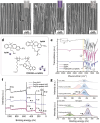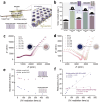Tailoring Polymer Coatings and Grafting Structures for Photoswitchable Ionic Transport in Solid-State Nanochannels
- PMID: 39971713
- PMCID: PMC11980769
- DOI: 10.1002/asia.202401684
Tailoring Polymer Coatings and Grafting Structures for Photoswitchable Ionic Transport in Solid-State Nanochannels
Abstract
Photoresponsive ion nanochannels have gained significant attention for their ability to regulate ionic transport in response to external stimuli. The potential of molecular and polymeric architectures in the nanochannels to further enhance and modulate these behaviors, however, remains underexplored. In this work, we explore the integration of spiropyran-based polymers into anodic aluminum oxide (AAO) nanochannels, resulting in tailored photoresponsive behaviors. Spiropyran undergoes reversible ring-opening isomerization upon UV irradiation, which leads to changes in the packing and polarity of polymer chains within the nanochannels. The polySp-coated and polySp-grafted AAO systems, fabricated via solution wetting and surface-initiated atom transfer radical polymerization (SI-ATRP), exhibit unique macroscopic and microscopic responses, including reversible color changes, wettability adjustments, and modulation of ion transport under UV and visible light. These findings demonstrate the potential of spiropyran-functionalized nanochannels for applications in optical information storage, photogated materials, and sensors. By manipulating molecular architecture and nanoconfinement, this work paves the way for the design of next-generation photoswitchable systems with enhanced multifunctionality.
Keywords: Anodic aluminum oxide; Ion conductivity; Photochromism; Photoresponsive; Spiropyran.
© 2025 The Author(s). Chemistry - An Asian Journal published by Wiley-VCH GmbH.
Conflict of interest statement
The authors declare no conflict of interest.
Figures





References
-
- Yu D., Xiao X., Shokoohi C., Wang Y., Sun L., Juan Z., Kipper M. J., Tang J., Huang L., Han G. S., Jung H. S., Chen J., Adv. Funct. Mater. 2023, 33, 2211983.
-
- Li J., Zhang K., Zhao X., Li D., ACS Appl. Mater. Interfaces 2022, 14, 27130–27139.
-
- Yameen B., Ali M., Neumann R., Ensinger W., Knoll W., Azzaroni O., Nano Lett. 2009, 9, 2788–2793. - PubMed
-
- Hou X., Yang F., Li L., Song Y., Jiang L., Zhu D., J. Am. Chem. Soc. 2010, 132, 11736–11742. - PubMed
-
- Lee M.-J., Chen Y.-F., Lee L.-R., Lin Y.-L., Zheng S., Chang M.-H., Chen J.-T., Chem. Eur. J. 2023, 29, e202301012. - PubMed
Grants and funding
- 112-2628-E-A49-012/2030 Cross-Generation Young Scholars Program of the National Science and Technology Council, Taiwan (NSTC)
- 113-2628-E-A49-006/2030 Cross-Generation Young Scholars Program of the National Science and Technology Council, Taiwan (NSTC)
- Center for Emergent Functional Matter Science of National Yang Ming Chiao Tung University
- Ministry of Science, Research and Arts of Baden-Württemberg (MWK)
LinkOut - more resources
Full Text Sources

